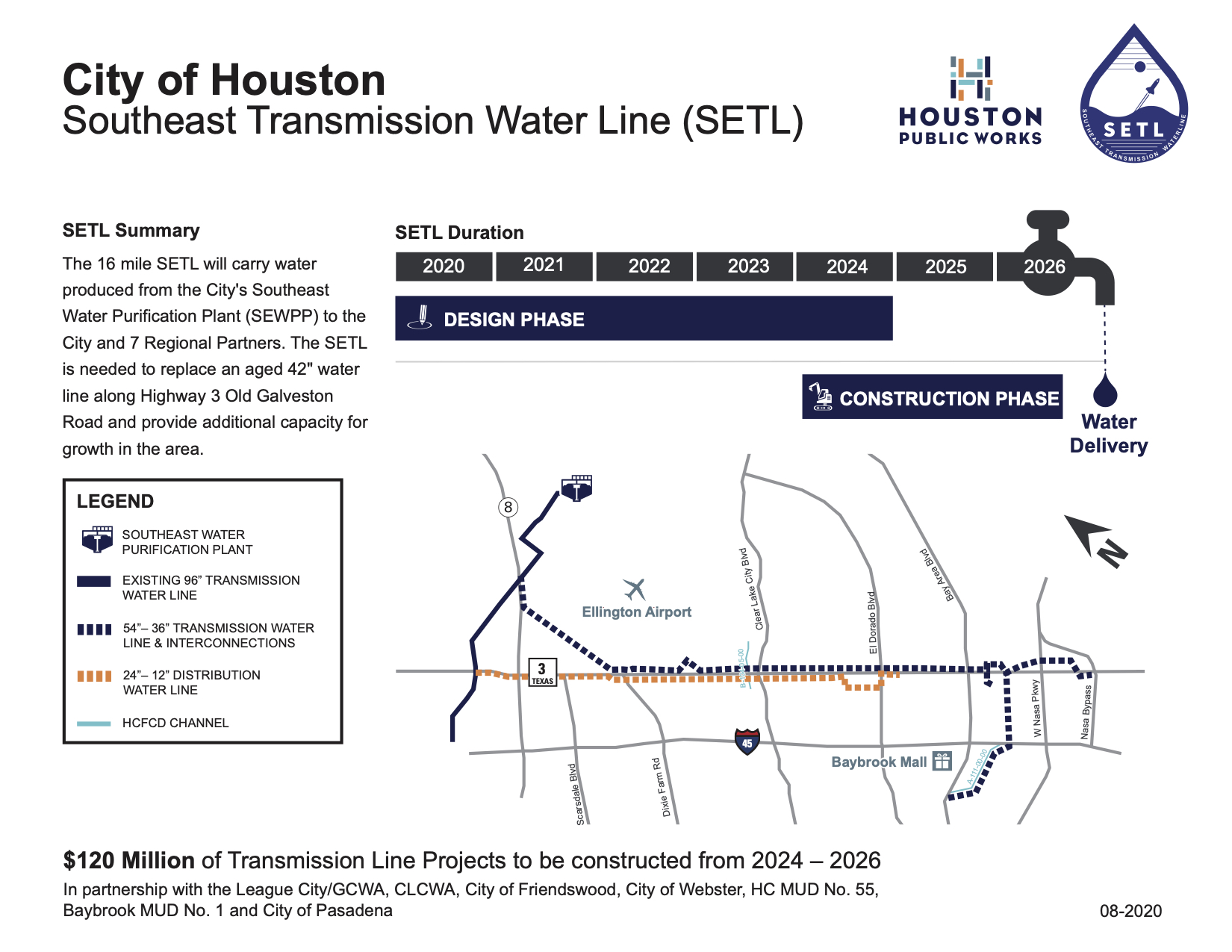Faced with an aging drinking water transmission main approaching the end of its design life, Houston Public Works and several local partners have begun design work on a nearly 18 mi long, $120 million replacement project. To be installed in a densely developed region, the Southeast Transmission Water Line will serve a fast-growing region of the Houston metropolitan area.
Reasons for replacement
The new transmission main — which ranges in diameter from 36 to 54 in. — will replace an existing 42 in. diameter main that was installed in the early 1970s. As it nears the 50-year mark, the main has begun showing signs of age, says Melissa Mack, P.E., M.ASCE, a vice president and principal for the planning, engineering, and program management firm Lockwood, Andrews & Newnam Inc., which is serving as the technical adviser for the Southeast Transmission Water Line project. In recent years, the existing main has experienced numerous leaks, typically at the joints, says Mack, who is the primary project manager.
Given the age of the pipeline and its history of leaks, the city of Houston and its partners on the project decided that the time had come to replace the existing main, says Panduranga “P.K.” Kuruva, P.E., the managing engineer of the surface water program for Houston Public Works. “After 50 years, we cannot take more chances,” Kuruva says.
The existing line also is located within the right of way of Texas State Highway 3 (see project map, below), which the Texas Department of Transportation plans to expand in the future. As a result, “there is a need for the city and its partners to have a new line in a space where they have control over it without intruding into the Texas Department of Transportation’s right of way,” Mack says.
Many partners, multiple sections
The new Southeast Transmission Water Line will connect to an existing 96 in. diameter pipeline that conveys water that has been treated at Houston’s 200 mgd Southeast Water Purification Plant, which is owned by Houston and the other entities participating in the Southeast Transmission Water Line project. After extending south through the city of Houston’s Ellington Airport, the new line will continue southeast along Highway 3 but on the opposite side of the roadway from where the existing line is located.

Overall, the project consists of two parts: 11.1 mi of new transmission main that the city of Houston is implementing with the financial assistance of seven local partners and 6.6 mi of a smaller-diameter distribution line that Houston is funding on its own, according to Mack. For the shared portion of the project, Houston is contributing $17.2 million. The other participating governmental entities contributing to the shared portion are League City ($52.4 million), the city of Friendswood ($12.5 million), the city of Webster ($9.5 million), the Clear Lake City Water Authority ($9.4 million), the Harris County Municipal Utility District 55 ($9.1 million), the Baybrook MUD No. 1 ($7.5 million), and the city of Pasadena ($47,000).
The new transmission main must pass through a “congested” area, Mack says, adding to the challenges that come with any pipeline project. “There are over 100 oil and gas pipelines that we’re going to be crossing,” Mack says. In addition, where the main will pass through Ellington Airport, the project will be subject to special regulations and requirements set by the U.S. Federal Aviation Administration. Houston’s status as a world leader in energy also adds its own wrinkle to the project.
As much as possible, the pipeline will be installed by means of open-cut installation, with trenchless construction used to cross beneath creeks, other pipelines, and roadways.
Significant effort will need to be expended on obtaining easements for the project. Currently, at least 200 easements are needed, though it is likely that more will be necessary, Mack says. “That number is only going to increase because as the designs progress, we’ll identify other areas where we’ll need to get access easements so that the city can maintain the pipeline,” she notes.
The new transmission main is being designed in four sections: 3.8 mi of 54 in. diameter pipe, 3.2 mi of 54 in. diameter pipe, 1.7 mi of pipe ranging in diameter from 42 to 48 in., and 2.4 mi of 36 in. diameter pipe. Work on the four transmission main design contracts began in May 2020 and is expected to be completed in 2022, Kuruva says. In accordance with the city of Houston’s specifications, the pipeline will be constructed of either steel, ductile iron, bar-wrapped concrete, or prestressed concrete cylinder pipe.
The city of Houston’s 6.6 mi of smaller-diameter distribution line, the second part of the project, is being designed in two sections: 2.1 mi of 24 in. diameter pipe and 4.5 mi of pipe ranging in diameter from 12 to 20 in. Of the two design contracts, one is nearly complete and will be wrapped up in early 2021, while the other is on hold as the city examines realignment options, Kuruva says.
All told, the entire project is expected to be completed in approximately six years, Mack says. “We’re working toward the delivery of water probably by the end of 2026,” she notes.




